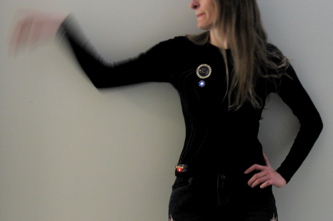Leah Buechley from the MIT lab gives detailed instructions on creating accelerometer t-shirt with LED lights using the LilyPad Arduino kit. The LilyPad provides basic tools for building wearable electronic clothing, so I believe it is worth studying one of Leah's tutorials. Our team is planning on building a LED panel that reacts to outside or internal influences, so tutorial will hopefully give me a good sense on construction based on sensors.
These are some of the materials needed for the construction:
LilyPad Arduino Main Board, power supply (we are planning on using batteries that are going to be part of the stretch suit), USB Link, accelerometer, conductive thread, LED, digital multimeter, needle, fabric paint, fabric glue, needles, puffy fabric paint, etc.
Procedure:
1. Stitch the LilyPad and the power supply on the garment (make sure they remain in close distance for strong connection).
2. Mount the accelerometer and LED (seal knots with fabric glue).
3. Insulate power lines with puffy fabric paint (we may just attach another layer of fabric on top of the LED panel to create an illuminating effect).
4. Program the Arduino software (my team may program the LilyPad to react to the music playing).
The actual construction of the LED panel, with the right materials, seem simple and intuitive. The team's main concern should be the programming aspect of the LED panel.
Some ideas for programming
- LED reacts to the bass of the music
- LED reacts to the loudness of the music (using sound sensors)
- LED generates graphics pre-programmed for each beat sequence or main music
In order for the LED panel to generate graphics, each LED needs to be constructed into a grid system or an array. It needs to be identified based on its location, and each LED will be instructed independently.The problem with this task is that each LED would have to be connected to the LilyPad separately, and I'm afraid it won't provide sufficient ports. Also, translating the sensors may be a challenge because reading music requires skills to identify amplitude and timing.
Source: http://web.media.mit.edu/~leah/LilyPad/build/accelero_shirt.html



Very useful post. This is my first time i visit here. I found so many interesting stuff in your blog especially its discussion. Really its great article. Keep it up. night light lamps
ReplyDelete